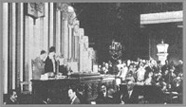- English
- Español
Brief History of the Commission
In 1922 the Pan American Association for the Advancement of Women was founded in order to influence the outcome of the Fifth International Conference of American States in Santiago, Chile (1923) from the perspective of the legal status of women and their right to vote. To that end, a number of "unofficial" female delegates came to the Conference and engaged in an active lobbying campaign to promote women's suffrage.
During the 1923 conference a resolution, proposed by Máximo Soto Hall of Guatemala, mandated that future Conferences study ways to eliminate constitutional and other legal discrimination against women. The resolution was eventually adopted unanimously by the Conference, providing the framework for women of the Americas to enjoy the same civil and political rights as men. The Conference also adopted a resolution calling for the inclusion of women in the delegations to future conferences.
Despite the expectations raised in 1923, not one woman was included in the delegation of any country to the Sixth International Conference of American States in (Havana, 1928). As a result, women from across the Americas mobilized to demand that they be allowed to participate in conference. They also urged members of the Conference to ratify an Equal Rights Treaty drafted by Alice Paul of the National Women's Party in the United States. The treaty would have moved the consideration of women's rights into political debates throughout the hemisphere. However, the official representatives of the 21 nations present at the conference argued that only they were allowed to speak on the floor and that the meeting's agenda had no room for discussion of a treaty on equal rights.
Although the Treaty for Equal Rights was not ratified, the decision was made to create the Inter-American Commission of Women (CIM). CIM was charged with conducting a study of the legal status of women in the Americas, which would be presented to the next International Conference of American States (Montevideo, 1933). The creation of CIM was the product of emerging women's movements throughout the hemisphere and reflected growing cooperation between the women of North, Central and South America. Doris Stevens, the first president of CIM, and many other feminist leaders often invoked the notion of Pan Americanism. In her address to the 1928 conference, Stevens stressed "the necessity of action through the Pan American Conference, not by separate countries, in obtaining equal rights for women in all the American republics."
Montevideo (1933) marked a major turning point in inter-American relations, ushering in an era of greater mutual respect and cooperation between the nations of the Americas. Appropriately, it was also the occasion of a major victory for the women of the Americas in their struggle for equality. This was the first Conference to see women included in the attending delegations, where the CIM President was scheduled to present a study on the status of women in the Americas.
Once again, the Conference did not approve the Treaty on the Equality of Rights for Women, although four countries (Cuba, Ecuador, Paraguay, and Uruguay) did sign it. The Conference instead adopted the Inter-American Convention on the Nationality of Women which enabled women to retain their own nationality in the event of marriage to a man of another nationality. This treaty was the first international legal instrument to address the rights of women and became a catalyst for recognition by the League of Nations of the existence and validity of the women's rights movement in the region.
Read more…(PDF)



